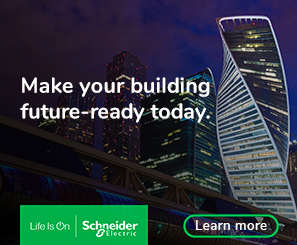Sustainable Innovation Starts at Home: The Singapore Story
by Jai Thampi
Published 04-13-21
Submitted by Schneider Electric

Sir Isaac Newton was at his best when he was working from home. The legend goes that when the polymath stayed at home to avoid the plague of 1665, he discovered the laws of gravity, optics, and invented calculus. Periods of hardship and adversity have spurred humans to do great things and make some of our most important discoveries. Over the last year many have continued this tradition, including in the areas of sustainable innovation. For instance, preliminary data shows a record growth in the number of startups during the tumultuous months of 2020.
As a Singaporean, it is special for me to celebrate the innovations and advancements made here over the last year. With its bustling startup scene and entrepreneurial spirit, Singapore has long been a world-leading centre of innovation, particularly when it comes to sustainable development – an area that hits very ‘close to home’ for me. That’s why I was so excited when the plan to build a 42,000-home eco smart city in Tengah was announced. With homes being central to our daily lives in the new normal of the pandemic, it’s great to see the smart homes project advocating green design principles, smart technology and energy efficiency, while keeping people at its core.
Without immediate action, the earth is expected to be 4.1°C – 4.8°C warmer by the end of the century. This means Singapore’s maximum daily temperatures could reach 35-37°C by 2100 if carbon emissions continue to rise consistently. When it comes to urban development trends, Southeast Asia’s population stands at 660 million, making it the third largest region in the world after China and India. Its middle class is expected to double to reach 334 million people by 2030, with electricity demand also set to grow two-fold by 2025. As an urbanised city-state, Singapore presents an ideal test bed for sustainable smart city projects, and I believe the Tengah project could be an example for how to do innovation and achieve sustainability in our cities, and set a precedent for the entire region.
An experiment in sustainability
Singapore’s eco-town of Tengah is a marvel of sustainable urban planning. It will be the country’s first urban centre to have centralised cooling, automated trash collection, and will be built around a car-free zone. It’s not only about the novelty of the design, however. Singapore recognizes that we must build urban areas that are future-ready: that means being able to embrace emerging technologies like autonomous vehicles, while increasing investment in environmentally friendly and physically invigorating modes of transport like cycling or even walking.
One of the other important challenges that Tengah will attempt to address through sustainable smart tech is the level of energy and cost required to power heating, ventilation and air conditioning (HVAC) systems. This accounts for more than a third of typical household energy consumption, and global warming is likely only to exacerbate this dependence on costly and wasteful HVAC systems.
Yet, as Singapore’s smart home revolution has shown, rather than ripping out modern solutions that are crucial to our comfort – like HVAC – we can reimagine them. Cold water, chilled using solar power, will be piped though the smart city’s homes, meaning residents won’t need to install inefficient outdoor AC condensers. Digital connectivity, the ability to harness the power of solar, and a reimagined way we cool our homes will be at the heart of this sustainable urban wonder.
The price of sustainability?
It has been questioned before if investments in smart homes and net-zero building technologies is worth it from a commercial point of view. To put it simply – Yes it is. It’s time to banish the false dichotomy between sustainability and business success. Efforts to curb emissions can be achieved without impacting productivity and success, so long as we leverage the right tools and technologies and follow a data-led approach.
Smart, sustainable buildings are more efficient and waste less energy, cutting emissions as well as energy costs. Building managers can get unprecedented insight into their facilities, enabling them to innovate and find further efficiencies. Once all of a building’s systems and components are connected under one platform, advanced analytics and AI technology can be used to proactively hunt for energy waste, faults and efficiencies in real time – keeping emissions down and occupants safe.
Singapore at the forefront
When it comes to sustainable innovation and investment in technology, Singapore has always been open to trying and testing the latest smart technology innovations to future-proof the city-state. At Schneider we have had the opportunity to collaborate on many such digital infrastructure projects and to incubate innovation.
For example, visitors can experience cutting-edge sustainable living at Marina Bay Sands (MBS) today. One of the most iconic, sustainable, and successful real estate projects ever built, MBS isn’t just a sought-after place to shop or stay, but also a showcase of what is possible when it comes to people-centric and sustainable design. Schneider Electric had partnered with MBS to reduce its energy consumption by 34% since opening in 2012. This was achieved with the help of 110,000 sensors and 150 solar panels, installed and operating while their business was constantly expanding. Despite this, the payback (ROI) time for the project was only three years. This project is something to learn from and perhaps emulate when pursuing high-rise housing projects.
Singapore’s innovative sustainability projects show that we can continue creating urban wonders that are sustainable, resilient and people-centric at every level. Singapore’s smart city innovations are only a sign of what’s to come. Its Green Plan 2030 already intends to build 60,000 EV charging points with 8 EV-ready towns by 2025, with 80% of Singapore’s buildings targeting green status by 2030.
The homes and buildings of the future will be more digital and more electric, powered by software and a bevy of connected devices and sensors. Accurate, real-time analytics will not only make our dwellings smarter and more sustainable, but also improve the safety, wellbeing and happiness of the inhabitants. I look forward to seeing Singapore become a trailblazer on many more of these innovations in the years to come.
If you found this blog to informative, do check out my recently published piece on why Net-Zero cities can’t exist without sustainable smart home
Jai Thampi
Jai Thampi, Senior VP Strategy & Innovation at Schneider Electric’s Home & Distribution division, is an established thought leader in strategy, digital transformation and corporate innovation in B2C and B2B domains. An international keynote, and twice recipient of the 'Most Impactful Smart Cities Leader' global award in 2020 and 2019, Jai also serves as advisor on the board of tech startups in Asia, and has previously held leaderships roles in leading multinationals like Cisco, Electrolux, Philips and Belkin.

Schneider Electric
Schneider Electric
Schneider Electric is a European multinational company providing energy and automation digital solutions for efficiency and sustainability.
More from Schneider Electric

